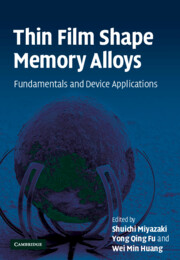Book contents
- Frontmatter
- Contents
- List of contributors
- Preface
- Abstracts of chapters
- 1 Overview of sputter-deposited TiNi based thin films
- 2 Martensitic transformation in TiNi alloys
- 3 Deposition techniques for TiNi thin film
- 4 TiNi multilayer thin films
- 5 Crystallization and microstructural development
- 6 Mechanical properties of TiNi thin films
- 7 Stress and surface morphology evolution
- 8 Ion implantation processing and associated irradiation effects
- 9 Laser post-annealing and theory
- 10 Overview of thin film shape memory alloy applications
- 11 Theory of SMA thin films for microactuators and micropumps
- 12 Binary and ternary alloy film diaphragm microactuators
- 13 TiNi thin film devices
- 14 Shape memory microvalves
- 15 Superelastic thin films and applications for medical devices
- 16 Fabrication and characterization of sputter-deposited TiNi superelastic microtubes
- 17 Thin film shape memory microcage for biological applications
- 18 Shape memory thin film composite microactuators
- 19 TiNi thin film shape memory alloys for optical sensing applications
- Index
8 - Ion implantation processing and associated irradiation effects
Published online by Cambridge University Press: 23 February 2010
- Frontmatter
- Contents
- List of contributors
- Preface
- Abstracts of chapters
- 1 Overview of sputter-deposited TiNi based thin films
- 2 Martensitic transformation in TiNi alloys
- 3 Deposition techniques for TiNi thin film
- 4 TiNi multilayer thin films
- 5 Crystallization and microstructural development
- 6 Mechanical properties of TiNi thin films
- 7 Stress and surface morphology evolution
- 8 Ion implantation processing and associated irradiation effects
- 9 Laser post-annealing and theory
- 10 Overview of thin film shape memory alloy applications
- 11 Theory of SMA thin films for microactuators and micropumps
- 12 Binary and ternary alloy film diaphragm microactuators
- 13 TiNi thin film devices
- 14 Shape memory microvalves
- 15 Superelastic thin films and applications for medical devices
- 16 Fabrication and characterization of sputter-deposited TiNi superelastic microtubes
- 17 Thin film shape memory microcage for biological applications
- 18 Shape memory thin film composite microactuators
- 19 TiNi thin film shape memory alloys for optical sensing applications
- Index
Summary
Abstract
In this chapter, we describe the influence of ion implantation on the microstructural modifications in TiNi SMA thin films. We focus on investigations involving 5 MeV Ni ion irradiation since it can be used as a means to selectively alter the transformation characteristics and to develop NiTi based thin film actuator material for MEMS devices. The primary effects of ion implantation on microstructure are summarized.
Introduction
This chapter discusses the influence of high energy particle irradiation on the shape memory properties of shape memory alloy (SMA) thin films. In general, SMAs, like TiNi, are very sensitive to high energy particle irradiation and undergo structural changes that can suppress martensitic transformations and thus their shape memory properties. The simplified explanation for this sensitivity to particle irradiation is that the martensitic transformation relies on the local atomic order of the crystal. The introduction of defects by high energy particle irradiation, such as in ion implantation, can destroy the local structural and chemical order that suppresses the SMA's ability to undergo a martensitic transformation and the related shape memory properties. It is these detrimental effects that limit the use of SMA in harsh environments, like space, where the defect production from cosmic radiation can render SMA actuators inactive.
The negative effects of particle irradiation on shape memory properties can, in fact, be useful. If the high energy particle material interactions are well understood, they can be used to tailor the shape memory response and engineer monolithic SMA actuators.
- Type
- Chapter
- Information
- Thin Film Shape Memory AlloysFundamentals and Device Applications, pp. 193 - 225Publisher: Cambridge University PressPrint publication year: 2009
- 1
- Cited by



